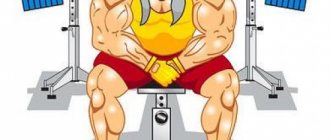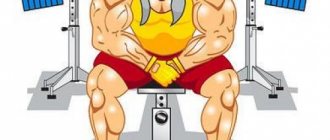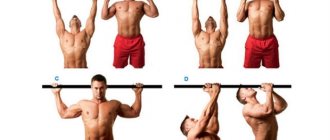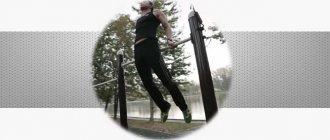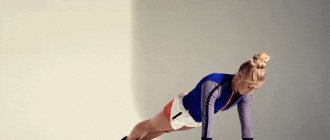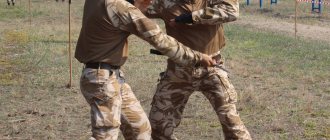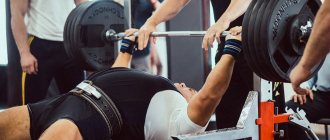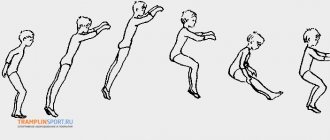is an amateur sport that appeared relatively recently, so it is logical that there is no generally accepted classification of standards, titles and categories for workout. If we take into account the recently growing popularity of workout, we should still have a scale for assessing the achievements and overall success of an athlete. This is quite serious work, which includes basic exercises for all muscle groups and individual special elements necessary for successful development in the field of workout. Based on the current situation in the workout world, we will highlight 9 categories, more about which you can find out below. In subsequent articles and videos, the sequence and training plan will be based on this classification. To motivate and maintain the trend of growing popularity of workout, it was created that anyone can watch. Also, everyone can appear on the list of street athletes themselves: we send a video or a link to a video with the completion of all the points for passing the category by e-mail:
. It is not necessary to pass all levels in a row; if you can immediately pass to the 2nd or 4th, then do so. When the rank increases, a note about this will be indicated next to it. So, the categories themselves:
1st category (beginner)
- Pull-ups - 8
times (we straighten our arms completely, when doing pull-ups, the chin is higher than the horizontal bar) - Dips on parallel bars - 15
times (the angle at the elbow when lowering should be no more than 45 degrees) - Push-ups from the floor - 30
times (when lowering, try to touch the floor with your chest, straighten your arms completely) - Squats - 15
times (the angle of the knee at the bottom of the squat should be no more than 45 degrees) - Bringing your feet to the horizontal bar - 1
time (without swinging, bring your socks to the bar, legs straight)
2nd category (sportsman)
- Pull-ups - 14
times - Dips on parallel bars - 25
times - Push-ups – 45
times - Squats - 25
times - Squats on one leg - 2
times (on each) (until the buttocks are completely lowered, stand on the entire foot) - Bringing your feet to the horizontal bar - 5
times - Corner bars - 5
seconds (legs above bars and straight) - Exit with force on one hand - 3
times (each) (you can jump between changing hands) - Lifting with inversion - 3
times - Captain's exit, officer's exit, crypt on the horizontal bar, coffin
3rd category (turntable)
- Pull-ups - 20
times - Dips - 35
reps - Push-ups - 55
times - 3
times (do it against the wall, touching the floor with your head) - Squats - 35
times - Squats on one leg - 5
times (on each) - Bringing your feet to the horizontal bar - 10
times - Corner bars - 15
seconds - Angle under the horizontal bar - 3
seconds (shoulder-width grip) - Exit with force on one arm - 8
times (each) - Exit on two hands - 2
times - Lifting with inversion - 8
times - Rivet on bars, lock, feather
4th category (athlete)
- Pull-ups - 25
times - Pull-ups on one arm - 1
time (on each) - Dips - 41
reps - Push-ups – 65
times - Handstand push-ups - 8
times - Squats - 45
times - Single leg squats - 8
(each) - Bringing your feet to the horizontal bar - 15
times - Parallel bars corner - 25
seconds - Angle under the horizontal bar - 6
seconds (narrow grip) - Exit with two arms - 5
times - Typewriter - 4
times - Swallow - 5
seconds
5th category (athlete)
- Pull-ups - 30
times - One-arm pull-ups - 3
times (each) - Dips - 47
reps - Push-ups – 75
times - Handstand push-ups - 13
reps - Squats - 55
times - Single leg squats - 12
(each) - Bringing your feet to the horizontal bar - 20
times - Parallel bars corner - 35
seconds - Angle under the horizontal bar - 10
seconds (shoulder-width grip) - Exit with two arms - 9
times - Typewriter - 8
times - Swallow - 10
seconds - Flag – 5
seconds (legs together, straight) - 5
seconds (legs and arms are straight, the body does not bend)
6th category (Olympian)
- Pull-ups - 35
times - Pull-ups with extra weighing 10 kg - 10
times - One-arm pull-ups - 6
times (each) - Dips - 53
- Push-ups on uneven bars with extra. weighing 20 kg - 15
times - Push-ups – 85
times - Handstand push-ups - 18
reps - Squats with additional weighing 20 kg - 20
times (weight on the neck or in a backpack) - Single leg squats - 16
(each) - Bringing your feet to the horizontal bar - 25
times - Corner bars - 45
seconds - Angle under the horizontal bar - 13
seconds (narrow grip) - Exit with two arms - 13
times - Typewriter - 12
times - Swallow - 15
seconds - Checkbox - 10
seconds - Horizontal emphasis under the horizontal bar - 10
seconds - 3
seconds (arms and legs are straight)
Candidate Master of Sports (CMS)
- Pull-ups - 40
times - Pull-ups with extra weighing 15 kg - 15
times - One-arm pull-ups - 9
times (each) - Dips - 60
reps - Push-ups on uneven bars with extra. weighing 25 kg - 20
times - Push-ups – 95
times - Handstand push-ups - 22
reps - Horizontal push-ups - 2
times (legs together and straight) - Squats with additional weighing 30 kg - 25
times - Single leg squats - 20
(each) - Bringing your feet to the horizontal bar - 30
times - Parallel bars corner - 55
seconds - Angle under the horizontal bar - 16
seconds (grip - hands shoulder-width apart) - Exit with two arms - 17
times - Typewriter - 16
times - Swallow - 20
seconds - Checkbox - 15
seconds - Horizontal emphasis under the horizontal bar - 15
seconds - Horizontal emphasis on the floor - 7
seconds
Master of Sports (MS)
- Pull-ups - 45
times - Pull-ups with extra weighing 20 kg - 15
times - One-arm pull-ups - 12
times (each) - Dips - 68
reps - Push-ups on uneven bars with extra. weighing 30 kg - 25
times - Push-ups - 100
times - Handstand push-ups - 26
reps - Horizontal push-ups - 6
times - Squats with additional weighing 40 kg - 30
times - Squats on one leg with extra. weighing 16 kg - 10
times (hold the weight in front of you with straight arms) - Bringing your feet to the horizontal bar - 35
times - Parallel bars corner - 65
seconds - Angle under the horizontal bar - 20
seconds (narrow grip) - Exit with two arms - 20
times - Typewriter - 20
times - Swallow - 25
seconds - Checkbox - 20
seconds - Horizontal emphasis under the horizontal bar - 20
seconds - Horizontal emphasis on the floor - 11
seconds
God of Workout
- Pull-ups - 50
times - Pull-ups with extra weighing 25 kg - 20
times - One-arm pull-ups - 15
reps (each) - Dips - 75
reps - Push-ups on uneven bars with extra. weighing 35 kg - 30
times - Push-ups – 110
times - Handstand push-ups - 30
reps - Horizontal push-ups - 10
times - Squats with additional weighing 50 kg - 35
times - Squats on one leg with extra. weighing 24 kg - 12
times - Bringing your feet to the horizontal bar - 40
times - Parallel bars - 80
seconds - Angle under the horizontal bar - 25
seconds (any grip) - Exit with two arms - 25
times - Typewriter - 25
times - Swallow - 30
seconds - Checkbox - 25
seconds - Horizontal emphasis under the horizontal bar - 25
seconds - Horizontal emphasis on the floor - 15
seconds
Base:
1) Pull-ups – 10 2) Dips – 15 3) Push-ups – 20 4) Raising straight legs while hanging on the horizontal bar (toes touch the bar) – 3
Elements:
1) Inversion lift – 3 2) Captain lift – 1 3) Angle under the horizontal bar (shoulder-width grip) – fix. 4) Exit by force on one arm – 1 (each)
IV Category
Base:
1) Pull-ups - 25 2) Push-ups on parallel bars - 30 3) Push-ups from the floor - 50 4) Raising straight legs while hanging on a horizontal bar (toes touch the bar) - 20 5) Push-ups in a vertical handstand against a wall - 5
Elements:
1) Force-out for two – 10 2) Force-out for two with a narrow grip – 5 3) Force-out for two with a wide grip – 5 4) Force-out for two with a corner (first fix the corner, then perform an exit) – 1 5) Angle under the horizontal bar in a narrow grip - 5 seconds 6) Pull-ups on one hand (any quality) - 1 (on each hand) 7) Slow exit on two with an angle - 1 Horizontal hang from behind ("swallow") - 6 seconds
Horizontal hang from behind ("swallow") - 6 seconds
Horizontal bar in the opening
The simplest manufacturing option would be to prepare a steel pipe and a pair of wooden blocks. Holes are drilled in the center of the wooden supports, the diameter of which is equal to the diameter of the pipe. You will need to make two cross cuts at the ends of the pipe itself. Their depth should be about 5-7 cm. Two opposite petals should be cut off on both sides (the location of the remaining petals should be the same). Next, a horizontal bar is made in the apartment with your own hands according to a simple scheme:
Manufacturing:
- Wooden blocks are placed on the pipe.
- The petals are unbent; they should fit tightly to the wooden base (you can prepare small indentations with a chisel).
- The installation location of the elements is marked in the opening.
- Holes are prepared on the wall, on wooden blanks and metal petals.
- The pipes are fixed along the prepared holes using wooden blocks.
At this stage, you can test the design and then play sports right at home.
V Rank
Base:
1) Pull-ups - 30 2) Push-ups on parallel bars - 40 3) Push-ups from the floor - 60 4) Raising straight legs while hanging on a horizontal bar (toes touch the bar) - 25 5) Push-ups in a vertical handstand against a wall - 8
Elements:
1) Power-up for two – 15 2) Slow way out for 2 with an angle – 3 3) Pull-up on one arm (without jerking) – 3 (on each arm) 4) Towel in front – 1 (both sides) 5) Horizontal hang front – 3 seconds 6) Horizontal support on half-bent arms (legs together and straight) – 3 seconds 7) Power rotation forward – 1 Horizontal hang from behind (“swallow”) – 10 seconds 9) Horizontal support under the horizontal bar – 6 seconds 10) Angle under the horizontal bar in a narrow grip – 7 seconds 11) Flag – 4 seconds
Horizontal hang from behind (“swallow”) – 10 seconds 9) Horizontal support under the horizontal bar – 6 seconds 10) Angle under the horizontal bar in a narrow grip – 7 seconds 11) Flag – 4 seconds
Fastening the horizontal bar to a wall made of slotted bricks using a chemical anchor
Hanging a horizontal bar on a wall made of slotted bricks using dowels is quite problematic. The reason for the failure is the voids in the material in which the fasteners are not properly fixed.
To fasten the horizontal bar in a slotted brick, you can try using a special dowel, in which the lamellas open 360 degrees.
If this does not help, then the best option is a chemical anchor.
The technology for attaching a horizontal bar in slotted brick (warm ceramics) is somewhat different from the method of attaching a sports exercise machine to “chemistry” in a concrete wall.
We proceed according to the following scheme:
- Holes in the brick wall are drilled from a diameter of 10 mm to a diameter of 14 mm.
To reliably fix the pin in the slotted brick, you need a special sleeve with a diameter of 14 mm and a length of 90 mm, which will form a hole in the voids of the material. You can buy a ready-made plastic sleeve.
Or make it from a stainless steel mesh metal sleeve, 1 m long.
In this case, the required length of the hole drilled in the wall is cut off from the sleeve. One end is flattened with pliers, and the sleeve is ready.
- Buy a stud with a diameter of 10 mm and cut off the fastening element from it at the rate of: 200 mm (depth of the already drilled hole) + thickness of the bracket + washer + nut + 4 mm (reserve).
The length of a homemade hairpin in the case of using a plastic sleeve (9 cm long) is about 11 cm.
- Insert all the sleeves into the holes in the wall.
- Without breaks, within 5 minutes, fill all the cartridges with the chemical composition.
- Insert all the pins by turning them clockwise.
- While the composition has not set, put on the brackets from the horizontal bar to accurately center all the studs.
The chemical anchor sets in 5-7 minutes. After 30 minutes, you can hang the horizontal bar on the studs and, placing washers, tighten the nuts. When the composition sets, the chemistry heats up. This is a normal process.
After the mixture hardens, a strong connection is obtained that can withstand a load of up to 500 kg per attachment point. In fact, it is possible to pull out a stud attached to a chemical anchor from a wall only by destroying the material.
Important: for indoor use in residential premises, you must use a chemical anchor that does not contain harmful styrene!
VI Category (CMS in workout)
Base:
1) Pull-ups - 35 2) Push-ups on parallel bars - 50 3) Push-ups from the floor - 70 4) Raising straight legs while hanging on a horizontal bar (toes touch the bar) - 30 5) Push-ups in a vertical handstand against a wall - 16
Elements:
1) Exit with force for two – 20 2) Horizontal support on straight arms (straight legs apart or together) – 3 seconds 3) From the horizontal support under the horizontal bar (1 sec) force yourself down into a horizontal hang from behind (3 sec) 4) Horizontal push-ups ( straight legs apart or together) – 3 5) One-arm pull-ups (without jerking) – 5 (on each arm) 6) One-arm pull-ups in a “towel in front” (on each arm) – 1 7) Horizontal front hang – 6 seconds Horizontal hang from behind (“swallow”) – 15 seconds 9) Horizontal support under the horizontal bar – 10 seconds 10) Angle under the horizontal bar in a narrow grip – 10 seconds 11) Flag – 8 seconds
Horizontal hang from behind (“swallow”) – 15 seconds 9) Horizontal support under the horizontal bar – 10 seconds 10) Angle under the horizontal bar in a narrow grip – 10 seconds 11) Flag – 8 seconds
VII Category (MS in workout)
Base:
1) Pull-ups - 40 2) Push-ups on parallel bars - 60 3) Push-ups from the floor - 85 4) Raising straight legs while hanging on a horizontal bar (toes touch the bar) - 35 5) Push-ups in a vertical handstand against a wall - 25
Elements:
1) Pull-up with a force of two - 25 2) Horizontal support on straight arms (level legs together) - 3 seconds 3) Push-ups in a horizontal support (level legs together) - 5 4) Pull-ups on one arm (without jerking) - 7 (on each arm) 5) Horizontal hang from the front – 10 seconds 6) Horizontal hang from the back (“swallow”) – 25 seconds 7) Pull-up on one arm in the “towel in front” (on each arm) – 1 Horizontal support under the horizontal bar – 15 seconds 9 ) From the horizontal support under the horizontal bar (3 sec) forcefully lower into a horizontal hang from behind (6 sec) 10) Angle under the horizontal bar in a narrow grip – 15 seconds 11) Flag – 15 seconds
Horizontal support under the horizontal bar – 15 seconds 9 ) From the horizontal support under the horizontal bar (3 sec) forcefully lower into a horizontal hang from behind (6 sec) 10) Angle under the horizontal bar in a narrow grip – 15 seconds 11) Flag – 15 seconds
General provisions:
- The categories and standards are developed with the aim of stimulating the versatile, comprehensive development of those involved in workouts. The categories include basic exercises, after mastering which you can master the corresponding elements without any problems. The standards specifically include exercises not related
to balance, joint mobility or increased risk of injury.
The main factors are strength and endurance
. - To receive a rank, it is necessary to record on video the fulfillment of each standard that is assigned to the corresponding rank. Then make a video edit. Then you upload your montage to our group (BARSTYLERSKharkov). We evaluate it and, if everything is done within the rules, we give you a rating and place your video in the rating table of ratings. THERE IS NO TIME FRAME!
ANY TIME PERSPECTIVES BETWEEN FILMING OF INDIVIDUAL ELEMENTS ARE ALLOWED. If you, for example, apply for the 4th category, then you fulfill the standards of only the 4th category. There is no need to meet the standards of the previous categories. When editing, try to ensure that the order of the exercises matches the order in the list. - All elements must be performed in good quality
in accordance with the rules described below and video examples. If the exercise includes multiple repetitions, then they must be performed in a row without getting off the horizontal bar. - All exercises are performed on a rigid horizontal bar. Attempts on the gymnastic horizontal bar or on objects not intended for pull-ups will not be counted.
- The use of shoulder straps is prohibited. Gloves optional.
- Video recording must be of acceptable quality with sufficient lighting. The participant must be clearly visible in full height.
- In case of unsatisfactory fulfillment of any of the standards, the applicant must exceed the standard in better quality and post an updated installation.
- If the admins come to the conclusion that everything was done satisfactorily, then the applicant is assigned the appropriate workout rank and his name and video are included in the list of ranks.
- All video reports from 4th to 7th categories will be evaluated by three admins. Depending on the quality of execution, each exercise will be scored on a 10-point system. The average score for your report will influence your position in the ranking of dischargers. The passing score is 75% of the maximum possible number of points scored.
The resulting rank can be entered into the name instead of the nickname.
Rules:
Base
Pull-ups:
Pull-ups are performed with an overhand grip
(palms away from you). At the top point, the chin must be higher than the crossbar. Requires full extension of arms when lowering. When pulling up, you should avoid using your legs in the form of jerks, pushes, or swings. Try to keep your legs straight and together.
Dips:
In the upper position, the arms should be fully extended. In the lower position, the angle between the forearm and shoulder should not exceed 90 degrees (for those who don’t understand: the lower you go, the better). The body should be kept as level as possible (no swaying, no jerking, no writhing, etc.). There should not be a strong forward bend.
Pushups:
Hands shoulder width apart. At the top point, fully straighten your arms
. At the lowest point, the distance between the chest and the floor should be minimal. Place the camera in front of you. Keep your body straight, do not bend. Head raised.
Raising straight legs while hanging on the horizontal bar (toes touch the bar):
Try to keep your legs straight. The swing should be minimal. Grip (upper, lower) as desired. Don't bend your arms.
Vertical handstand push-ups against a wall:
Hands are slightly wider than shoulder width. Lowering to the maximum (until you touch your head). Push up until your arms are fully extended.
Elements
Inversion lift:
Legs should be straight. Be sure to straighten your arms in support.
Captain's Rise:
Performed by force (using the strength of the arms, and not sharply throwing the legs with the pelvis onto the horizontal bar). Preferably straight legs. After completion, you need to go out to sit.
Angle under the horizontal bar:
Legs should be straight. The angle between the legs and body should be 90 degrees.
Exit by force by one:
No swing. Without the help of legs. Mandatory straightening of the arms in support.
Exits with two strength (top, bottom, narrow and wide grip):
No swing. When lowering and when going into emphasis, you need to fully extend your arms. Both hands should move to the top position at the same time. Grip according to exit type. Leg assistance is minimal.
Horizontal hang from behind (“Swallow”):
The body should be smooth. The body should be parallel to the ground. Grip shoulder-width apart (overhand or underhand). Legs should be straight and flat.
Horizontal front hang:
The body should be smooth. The body should be parallel to the ground. Grip shoulder-width apart. Legs should be straight and flat.
Slow exit for two with a corner:
First fix the corner. The angle between the legs and body is 90 degrees. The pull-up should be slow (at least 3 seconds). Be sure to straighten your arms in support. In the lower position, you are allowed to bend your arms slightly.
Single pull-up:
If any quality is required, there is only one rule - the chin is above the horizontal bar in the upper position. In other cases: ● In the lower position, the hand must be level ● In the upper position, the chin must be above the horizontal bar ● Helping with legs, swinging, jumping from the ground is prohibited
Towel front:
When pulling up to one arm, the other arm should be straight. First you need to transfer your weight to your free hand, then go to point-blank range. When pushing, your arms should be straight.
Horizontal stop:
● The arms should be either straight or bent (depending on the requirement for the category) ● In the case of bent arms, the legs should be straight and together ● In the case of straight arms, the legs should be straight (if the 6th category is spread, on the 7th - mixed)
Forward power rotation:
The turn must be performed using force, and not by swinging the legs before performing the element.
Checkbox:
The body is parallel to the ground. Hanging sideways. Performed on any vertical apparatus. Hands are straight.
Hello, lovers of sports and a healthy lifestyle. Do you want people turning around to admire you? Then read and take notes in your sports notebook. Everyone knows:
- Bench press.
- Squat with a barbell.
- Deadlift.
But there is one more thing for the back - these are pull-ups with weights on the bar. For results in gaining muscle mass. The athlete’s muscles get used to it, thereby not receiving training stress and the impulse to grow in strength and volume. Additional weight will increase the load, which means it will force you to leave your “comfort zone”.
In essence, these are the same hanging lifts, only with additional weight: with a chain or belt, to which plates from a barbell or dumbbells are tied.
- Supraspinatus, infraspinatus, biceps and triceps brachii muscles.
- The levator scapulae muscle.
- Upper, lower parts of the trapezius muscle.
- Extensor carpi ulnaris and flexor carpi.
- The erector spinae muscle.
- Latissimus muscle.
Plus included in the work:
- Rectus abdominis muscle.
- Quadriceps and biceps femoris.
- Pectoralis major muscle.
Depending on the grip you choose, the load will vary.
Reverse and close grip - biceps and forearm.
The benefits and harms of pull-ups
Minimize the risk of harm to health by visiting a therapist first. If pathologies are detected, the doctor will develop a special program. Doctors do not always recommend hanging and doing pull-ups on an apparatus for people who have problems with the spine.
Positive sides:
- Correct posture.
- Prevention of spinal diseases.
- Muscle tone.
- Fast calorie burning.
Contraindications
The following health problems may interfere with exercise:
- Chronic diseases in acute form.
- Paralysis of arms and legs.
- Obesity.
- Heart failure.
- Poor blood flow to the brain.
Contraindications for implementation
Exercise is prohibited for chronic diseases of internal organs and vascular pathologies. Contraindications for women include uterine flexion, and for men – hernias of any location.
Other medical prohibitions and restrictions on performing isometric complexes to strengthen the abdominal muscles:
- Diseases and injuries of the spinal column. During exercise, this skeletal structure is subjected to significant stress. With displacement of the vertebrae and inflammatory processes, the clinical picture may worsen and severe pain may occur.
- Ptosis of internal organs. When they are lowered, physical tension is extremely undesirable.
- Hyperplasia in the pelvic area. The ban applies to both malignant and benign neoplasms.
- Postoperative rehabilitation period. As a result of physical activity, the seams may diverge.
- Pregnancy and postpartum period. Physical activity can provoke a threat of miscarriage and uterine bleeding. After childbirth, the immune system is depressed, which increases the likelihood of infection with viruses and pathogenic bacteria. Physical activity further increases the vulnerability of a weakened female body.
It is not recommended to strain the abdominal muscles and hip joint during a difficult menstrual cycle. This will lead to increased bleeding. Contraindications include chronic diseases of the digestive system - stomach ulcers, gastritis, colitis.
Techniques and types of pull-ups with weights
If you have learned the technique without weights, then there will be no difficulties. When working with cargo, consider the following nuances:
- Hang onto the horizontal bar from a stand without jumping.
- You can also go down through the stand.
- Eliminate rocking.
- Movements are smooth without jerking.
Use a vest as an additional load. The advantage over a weightlifting belt is that it does not put pressure on the spine.
- To ensure a secure grip, dry your hands with sports magnesium.
- Put on the weights and approach the horizontal bar so that it is above your head.
- Using a wall bars or stand, carefully perform the hang.
- As you exhale, bending your arms, smoothly rise to your chest.
- Pause briefly at the top, keeping your chin above the bar.
- As you inhale, controlling the fall of your body, lower yourself to a hanging position.
In order for your joints to get used to it, plan your first sessions using negative pulls.
- Stand on the bench so that your chin is above the bar.
- Bend your legs and lower yourself until your arms are almost bent at the elbows.
- Stand on the bench and take your starting position.
In addition to straight ones, when the crossbar touches the chest, pull-ups by the head are no less effective. I don't recommend it for beginners. Contraindicated for diseases of the cervical and shoulder girdle.
Example workout
At home
The advantage of pull-ups is that you can do without a gym membership. Stretch your shoulders and hands. Jumping rope will perfectly warm up your whole body. A backpack with books works well as a weighting agent. Exercising with weights at home is not much different from training in the gym, which we will look at below.
In the gym
At the gym, warm up on the treadmill. Seven minutes of running will be enough to prepare the body for work. Do 2 - 3 pull-downs of the upper block to the chest for 6-8 repetitions. Choose a projectile weight of 60-70 percent of your own body weight. It is better to set aside a separate day to work out your back.
First training option
After the warm-up described above, with an additional weight of 8 kg, do 5 sets of 5 reps. Rest between sets for 90 seconds. In the next workout, increase the weight of the load so that you can complete the program 5 sets of 5 times.
Second training option
Take the test before you start. Do pull-ups without a vest as many times as possible. Let's say it will be 25 times. Wear a vest with 6 kg. Your task is to do 25 pull-ups with as few approaches as possible.
Next session, try to do 25 reps with the same weight for 4 sets, etc.
Third training option
“Ladder” is familiar from the schoolyard. Suitable for improving endurance. The exercise is performed according to the scheme 1-2-3-4-5-4-3-2-1. Rest time between approaches is no more than 15 seconds.
Sets and reps
To develop strength endurance, perform 20-25 repetitions with a weight of 50-60 percent of the maximum. Quickly rise to the bar and slowly descend to a hanging position.
Working for mass means performing with a weight of 70 - 80 percent of the maximum weight. You need to go up to the bar slowly and go down quickly.
Larger weights will help improve strength, 85 - 95 percent of the maximum weight for 2 - 4 repetitions. Rest for at least 3-4 minutes.
As you perform, concentrate on the tension in your back. Bring your shoulder blades together as much as possible and try to touch the horizontal bar with your chest. Record a video and analyze what technical mistakes you make.
What weight to choose
For the first week, limit your weight to 5 kg. As you progress through the programs listed in the “Training Examples” section, increase the weights by three kilograms. Focus on your own feelings to prevent overtraining.
How to make a horizontal bar for an apartment with your own hands
The distance from the ceiling to the crossbar should be at least 35 cm, since when doing pull-ups you can hit your head on the ceiling. If you are lucky and have high ceilings, then you should hang the horizontal bar so that, standing on tiptoes on the floor, you can barely touch the bar of the horizontal bar with your fingertips. If you jump from a high horizontal bar, it will have a bad effect on your joints.
Even for the most complex wall model, 2-2.5 meters of profile pipe and about 1.5 meters of round pipe are enough. To make a horizontal bar for your home with your own hands, a sheet with the selected model and dimensions is pre-printed. For the frame, a profiled metal pipe 20*30*3 mm was used, for the crossbar and “handles” - a remnant of a curtain rod from Soviet times. The pipe is thin, but still holds up. To begin with, using a grinder, I sawed the profile pipe into pieces of the required length.
Start - cut the pipes into pieces of the required length, file the angle of the stops.
There are no corner stops in the diagram; they are made “by eye”. The angle is about 50°. The next thing to do is cook. With an inverter welding machine this is not too difficult. Moreover, the pipe has a thick wall: 3 mm is welded normally.
The result is two halves of the frame in the shape of the letter “G” - they need to be connected by jumpers. To ensure that the frame posts are parallel, we use strips that fix the parts at the same distance. At the same time, from scraps of stainless steel pipe, we weld handles at the bottom, which we will hold on to when pumping the press.
To ensure that the distance between the posts is the same, we use slats.
To make a tight connection between the round pipe and the rectangular one, a semicircle was cut out in the stand using a grinder. I had to modify it with a file, but the fit is very good. All that's left to do is boil it.
Design of the junction of a round and rectangular pipe.
To weld handles for a narrow grip to a round pipe, we also form recesses in the pipe sections. It is more difficult to cook them - the thickness of the pipe is much less. In general, other electrodes are suitable for welding stainless steel. Due to lack of experience, the seams turned out ugly, but without obvious defects.
Next you need to bend the pipe along the edges. To do this, insert a rod of smaller diameter into the pipe, take a gas burner, heat the bend, bending it little by little. You need to bend it 30°. To do this, I drew an angle on the floor with chalk, bending it and checking it against the drawn lines.
We add “holders” for a narrow grip, bend them and you can paint them.
We put an emery wheel on the grinder and clean the welding areas. Then, using a circle with a smaller grain, we remove plaque from the entire structure, additionally sanding the seams. Ready for painting. Spray paint was applied in three layers.
We also made the hooks for hanging the horizontal bar ourselves.
For wall mounting, hooks are made from a 15*4 mm metal strip. It was not easy to bend - holding the whole piece in tongs, we managed to bend it on both sides. The finished hooks were cut to the required length and holes were drilled for the dowels. A drill with a diameter of 8 mm was used, drilled 12 mm for the fastener heads. The hooks are cleaned and painted with the same paint.
Before making a horizontal bar, decide on the place where you will hang it. Not all spouses will calmly accept such an innovation... Homemade horizontal bar 3 in 1 on the wall in two working positions
Almost everything is ready. All that remains is to make pillows for the shoulders. For the base, pieces of plywood were taken, on them - thin furniture foam rubber in two layers, covered with eco-leather with holes. To fasten the leatherette, staples and a construction stapler were used, but you can also use furniture nails if you don’t have a stapler.
We make pillows under the shoulders.
Based on operating experience: wall hooks should be made longer, with at least three dowels. And one more thing: the design has been improved - the handles for a narrow grip in the version shown in the picture are uncomfortable, so another crossbar was welded.
Crossbar added.
The homemade homemade horizontal bar turned out to be a bit heavy - 19.8 kg, but in this form it is more convenient.
Conclusion
Weighting really does give you an increase in strength and mass. Attempts by an athlete to make it easier to perform or to chase a record number of times will not give the desired result.
Follow the technique, use sports nutrition for additional growth and enjoy the exercise. Listen to your body and the goal will be achieved.
Subscribe to articles, share useful information with friends on social networks. With this I say goodbye to you. Hopefully not for long.
– this is a rather young and not entirely common sport for our country. However, it deserves special attention. It is the workout that allows you to develop not only physically, but also spiritually. Thanks to this direction, young people have a great opportunity to form a strong, beautiful athletic body. In addition, workout is a real philosophy of a healthy lifestyle. Even when you just look at young people performing various elements on horizontal bars and uneven bars, sometimes it takes your breath away. If you haven’t really decided yet whether you want to go to street workout, pictures with inspiring examples will make the choice for you.
Accessories for horizontal bar
Specialized stores sell a large number of different accessories that hang on the horizontal bar: these are various handles and tips on handles, straps, hooks, and loops. Not all accessories are equally useful and convenient. For example, the rubber grips on the handles will quickly tear. In addition, such devices make your hands sweat and your grip strength decreases. Moreover, due to the abundance of accessories on the bar of the horizontal bar, you have less working space for exercises.
The most practical accessory is protective gloves for fitness, which will protect your palms from blisters.
Sources used: valsport.ru, playboyrussia.com, furnilux.ru, stroycollege12.ru, sportstyle-shop.com, proreyting.ru, dyatkovortp.ru, lifehacker.ru, housechief.ru, coream.ru, www.sports.ru , texnotoys.ru, creativportal.ru, bodybuilding-and-fitness.ru, vechnomolod.ru, mytrener24.ru, repaireasily.ru
Where to begin?
Having decided to devote themselves to workout, many people are faced with a number of issues that often become a stone wall between them and the sport. And, of course, the most popular question sounds something like this: “where to start?” First of all, you need to understand a couple of basic points. Do you know what street workout is and what ghetto workout is?
Street workout is street training where the main goal is technical training. This involves complicating existing elements and learning new ones. And ghetto workout is a strength direction. Here it is important to perform each element better and better each time. For example, gradually increase the number of pull-ups or hold the rack for as long as possible each time.
How to use a horizontal bar - the basics of pulling up on a horizontal bar
Since we decided to devote our review to the rules of a healthy lifestyle, it means that we cannot ignore some purely sports recommendations. Let's consider options for exercises on horizontal bars for different muscle groups. The simplest exercises on the horizontal bar are pull-ups. But take your time! Not so simple. Even a simple pull-up can train multiple muscle groups. It all depends on the grip. There are some of its varieties:
- classic (straight) - this is the usual pull-up when the palm covers the projectile from above;
- reverse grip - when performing the exercise, the palms are facing the person’s face.
What muscles does the direct grip train
? The reverse grip is a more professional way of working on the biceps. Completely different muscle groups are involved here.
To work your biceps correctly, pay attention to the position of your arms.
At the first stage of training, the most important role is played by developing the technique of training on the simulator. If you don't know where to start training on the horizontal bar, watch this video.
Power base
In general, workout for beginners is a completely separate topic. Before you jump straight into strength training, you need to determine whether you have a foundation. To do this, conduct the following experiment: do pull-ups on the horizontal bar, do push-ups on the uneven bars as many times as possible. It turns out that you can do more than 15 pull-ups and do more than 30 push-ups? If yes, then you can be congratulated: the base is already there. But if you fail to achieve such results, you will have to do some preparation.
First of all, it is necessary to focus on the number of pull-ups and push-ups. This should strengthen your ligaments and prepare you perfectly for strength exercises. However, even the existing base is enough to start training handstands. If you practice every day, about a month of training will be enough to learn how to do it properly.
Tunic to the front
This horizontal bar is very similar to the previous one, but it does not require any fastenings to the wall, no holes need to be drilled, the horizontal bar can be installed between the walls in the corridor (if they are not made of plasterboard). Quite a good choice for the home if you just want to do some stretching, and it's one of the cheapest options you can buy.
There are two options for possible fastening of the horizontal bar; in the first option, the kit includes two keys with which during installation you need to adjust a special screw mechanism so that the horizontal bar is held firmly between the walls. The second option is a horizontal bar installed in the door jamb, this option is not very convenient for adults, but just right for children! When installing the horizontal bar in this way, it is simply untwisted with your hands all the way to the sides of the door opening and is held in place due to this force.
The disadvantages include that it is attached to the wall only by thrust force, so very large and tall people, as well as those who would like to do active exercises (somersaults, somersaults) and similar exercises on the horizontal bar should not opt for it, as how it can fall off the wall while performing the exercise and you will get injured. It is better to use outdoor horizontal bars and parallel bars for active exercises.
Workout ranks
Giving preference to a sport such as workout, for beginners it often comes as a surprise that there are sports categories. And yet they exist. Unfortunately, workout is not included in the official list of sports in any country. However, shocks were still introduced to stimulate young people. This is a kind of motivation to move on.
There are 7 categories in total. Moreover, those who receive the 7th category are considered a master of sports. But in order to reach such a high bar, workout training must truly become a part of your life. To make this happen faster, watch videos about street workout more often ,
pictures can also serve as inspiration. Here are some of them.
Workout classes include 2 important components: elements and basic exercises. At the same time, there are only 5 basic exercises. The only exception is categories I and II. But the number of regulatory elements increases with each new category.
Horizontal bar in the doorway: nuances and a modern look
The crossbar in the doorway is one of the most common types of sports equipment of this type. It doesn’t take up much space, is easy to install, and costs a penny.
There are removable models, and they can be easily moved to another place, without consequences or traces
As you noticed, modern horizontal bars are no longer just a steel pipe attached to a spacer, it is a structure that can include several supports and special handles. Let's look at the variations of horizontal bars in the doorway:
- Structures on struts . Usually, in the places where the structure is fastened, there are special screw-in bolts that regulate the “depth” of screwing into the side walls of the opening. Horizontal bar with spacers
- Removable crossbar. In this case, the crossbars at the fastening points are fixed once and for all. To remove the horizontal bar, just lift the crossbar from the groove.
- Sliding crossbar. In such models, the crossbar usually consists of several cylinders that are assembled telescopically.
Elements of a sliding horizontal bar in a doorway
This type of horizontal bar is characterized by the most affordable cost and ease of installation. Most often, this design becomes more reliable due to the strong support, which is achieved by fastening on both sides at once.
